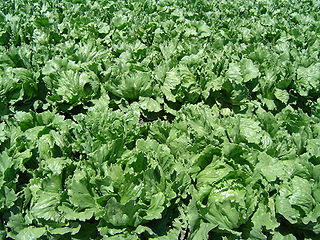
Lettuce is an annual plant of the daisy family, Asteraceae. It is most often grown as a leaf vegetable, but sometimes for its stem and seeds. Lettuce is most often used for salads, although it is also seen in other kinds of food, such as soups, sandwiches and wraps; it can also be grilled. One variety, the celtuce, is grown for its stems, which are eaten either raw or cooked. In addition to its main use as a leafy green, it has also gathered religious and medicinal significance over centuries of human consumption. Europe and North America originally dominated the market for lettuce, but by the late 20th century the consumption of lettuce had spread throughout the world. World production of lettuce and chicory for 2017 was 27 million tonnes, 56% of which came from China.

Asclepias tuberosa, the butterfly weed, is a species of milkweed native to eastern and southwestern North America. It is commonly known as butterfly weed because of the butterflies that are attracted to the plant by its color and its copious production of nectar. It is also a larval food plant of the queen and monarch butterflies, as well as the dogbane tiger moth, milkweed tussock moth, and the unexpected cycnia Hummingbirds, bees and other insects are also attracted.

Oxalis tuberosa is a perennial herbaceous plant that overwinters as underground stem tubers. These tubers are known as uqa in Quechua, oca in Spanish, yam in New Zealand and a number of other alternative names. The plant was brought into cultivation in the central and southern Andes for its tubers, which are used as a root vegetable. The plant is not known in the wild, but populations of wild Oxalis species that bear smaller tubers are known from four areas of the central Andean region. Oca was introduced to Europe in 1830 as a competitor to the potato, and to New Zealand as early as 1860.

Lactuca, commonly known as lettuce, is a genus of flowering plants in the daisy family, Asteraceae. The genus includes at least 50 species, distributed worldwide, but mainly in temperate Eurasia.
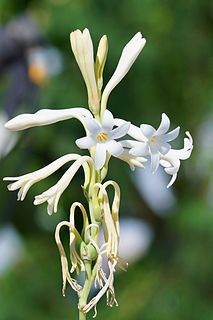
Agave amica, formerly Polianthes tuberosa, the tuberose, is a perennial plant in the family Asparagaceae, subfamily Agavoideae, extracts of which are used as a note in perfumery. Now widely grown as an ornamental plant, the species was originally native to Mexico.
Lactucarium is the milky fluid secreted by several species of lettuce, especially Lactuca virosa, usually from the base of the stems. It is known as lettuce opium because of its putative sedative and analgesic properties. It has also been reported to promote a mild sensation of euphoria. Because it is a latex, lactucarium physically resembles opium, in that it is excreted as a white fluid and can be reduced to a thick smokable solid.
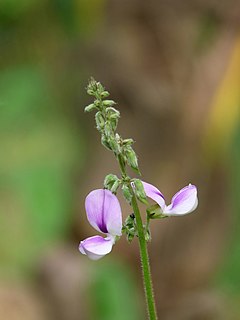
Pueraria is a genus of 15–20 species of plants native to Asia.
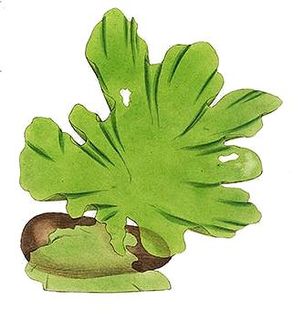
The sea lettuces comprise the genus Ulva, a group of edible green algae that is widely distributed along the coasts of the world's oceans. The type species within the genus Ulva is Ulva lactuca, lactuca being Latin for "lettuce". The genus also includes the species previously classified under the genus Enteromorpha, the former members of which are known under the common name green nori.
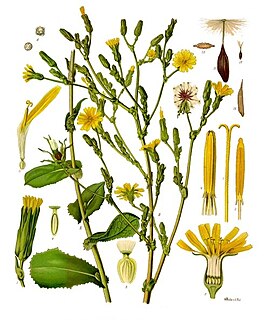
Lactuca virosa is a plant in the Lactuca (lettuce) genus, often ingested for its mild analgesic and sedative effects. It is related to common lettuce, and is often called wild lettuce, bitter lettuce, laitue vireuse, opium lettuce, poisonous lettuce, tall lettuce, great lettuce or rakutu-karyumu-so.
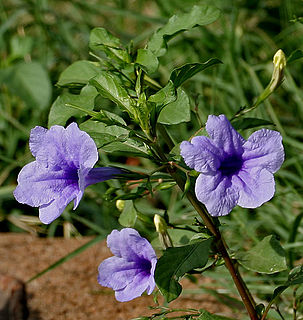
Ruellia is a genus of flowering plants commonly known as ruellias or wild petunias. They are not closely related to petunias (Petunia) although both genera belong to the same euasterid clade. The genus was named in honor of Jean Ruelle, herbalist and physician to Francis I of France and translator of several works of Dioscorides.

Lactuca serriola, also called prickly lettuce, milk thistle, compass plant, and scarole, is an annual or biennial plant in the dandelion tribe within the daisy family. It has a slightly fetid odor and is commonly considered a weed of orchards, roadsides and field crops. It is the closest wild relative of cultivated lettuce.

Byrsonima is one of about 75 genera in the Malpighiaceae, a family of flowering plants in the order Malpighiales. In particular in American English, they are known as locustberries. Another widely seen common name is serrets or serrettes.
Stemona tuberosa is a species of flowering plant in the family Stemonaceae. It is native to China, India, southeast Asia, and New Guinea. Hornets play an important role in seed dispersal by biting off the seed with its elaiosome and then carrying the seed away for about 100 m. There they chew off the elaiosome and abandon the seed which is likely to be taken by ants into their nest.

Lactuca canadensis is a species of wild lettuce known by the common names Canada lettuce, Canada wild lettuce, tall lettuce, and Florida blue lettuce. Its true native range is not clear, but it is considered to be a native of the eastern and central parts of North America. It naturalized in the western part of the continent as well as in Eurasia.
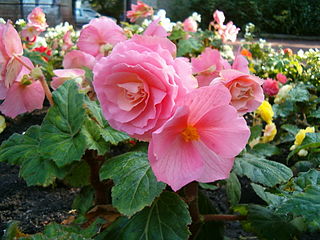
Tuberous begonias are a group of Begonia cultivars, sometimes regarded as some of the most spectacular of the genus.

Pueraria tuberosa, commonly known as kudzu, Indian kudzu, or Nepalese kudzu, Vidarikand, Sanskrit: Bhukushmandi (भूकुशमंडी) is a climber with woody tuberculated stem. It is a climbing, coiling and trailing vine with large tuberous roots. The tubers are globose or pot-like, about 25 centimetres (9.8 in) across and the insides are white, starchy and mildly sweet. Leaves are trifoliate and alternate, while the leaflets are egg-shaped, with round base and unequal sides. They are 18 cm (7.1 in) long and 16 cm (6.3 in) wide and are hairless above. Flowers are bisexual, around 1.5 cm (0.59 in) across and blue or purplish-blue in color. The fruit pods are linear, about 2–5 cm (0.79–1.97 in) long and constricted densely between the seeds. They have silky, bristly reddish-brown hair. Seeds vary from 3 to 6 in number.
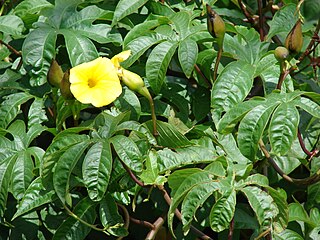
Distimake tuberosus, also known as Spanish arborvine or wood rose, is a vine in the family Convolvulaceae. It is native to the Americas, from Florida and Texas to Brazil, although considered by the USDA as introduced to the United States. It is an invasive species in a number of islands in the Indian and Pacific Ocean, such as New Caledonia.
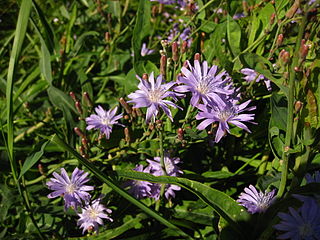
Lactuca tatarica, known as blue lettuce, is a Eurasian flowering plant in the chicory tribe within the daisy family, Asteraceae. It is widespread across much of Europe and Asia.

China is the world leader in lettuce production, producing half of the world's lettuce. Stem lettuce is grown in the country and the stems are prepared as a cooked vegetable. According to estimates given by the Food and Agriculture Organization (FAO) in 2006, China produced around 11,005,000 metric tonnes of lettuce on 500,250 hectares of land. In 2010, the FAO reported that some 12,574,500 tonnes of lettuce were produced during that year. Taiwan is also a producer of good quality head lettuce, which is an export commodity.
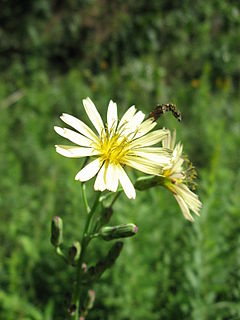
Lactuca indica, Indian lettuce, is a species of plant in the dandelion tribe within the sunflower family. It is native to western China, the Himalayas, and southwest Asia as far west as Turkey. It is widely introduced elsewhere, even as far as east Africa, and is thought to be an archaeophyte in Japan, brought in with rice cultivation.


















